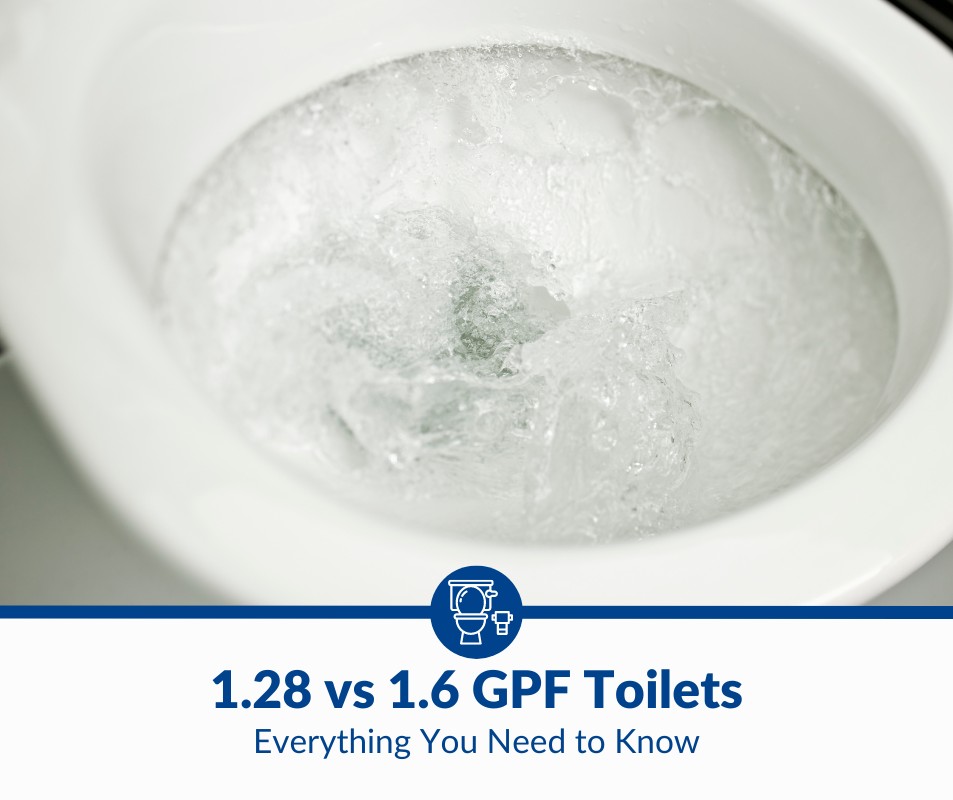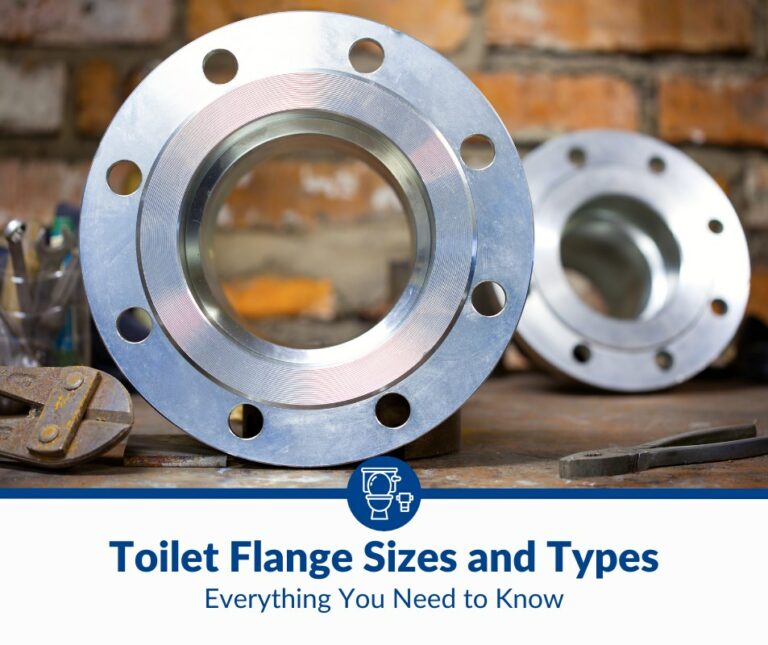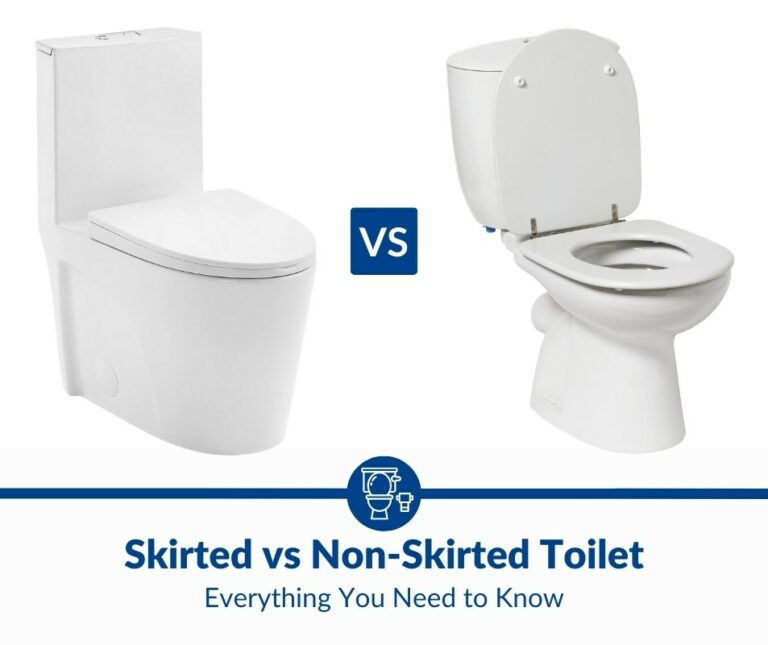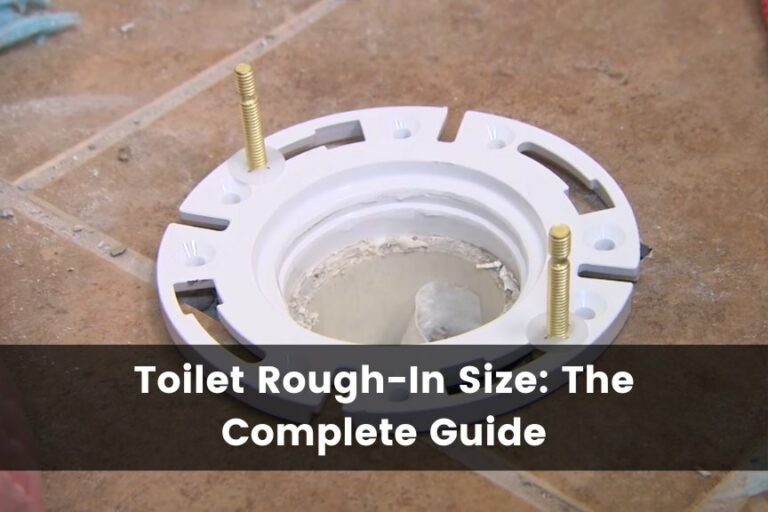1.28 vs 1.6 GPF Toilets: Which Is Better?
If you’re in the market for a new toilet, chances are you’ve come across two main alternatives while shopping – 1.28 and 1.6 GPF toilets. The choice can leave many overwhelmed, not knowing what option would best suit their preferences – remember, getting a type of toilet that’ll serve you well is essential; after all, you spend roughly 92 days of your life in your bathroom. So, when asked to decide between the two, which one should you go for?
Between a 1.28 GPF and a 1.6 GPF toilet, the former is better at limiting excessive water consumption, while the latter is better at flushing larger amounts of water and, thus, more powerful. The best type of toilet for your household will depend on which of these features you prioritize the most.
Below, I’ll expand on the topic even further, providing you with a detailed explanation of each option’s features, advantages, and drawbacks, as well as a direct comparison between the two. However, before we go any further, I wanted to clear up a term you’ll often be encountering throughout this piece, GPF – the abbreviation stands for gallons per flush, which indicates the volume of water your toilet uses per flush. With that cleared up, let’s get started!
Read Also: Toilet Flange Sizes and Types
1.28 GPF Toilets Overview
1.28 GPF toilets are excellent, more cost-efficient alternatives to their 1.6 GPF predecessors. As the name suggests, they use 1.28 gallons of water per flush or 4.85 liters. They’re more compact and feature a smaller valve than their counterparts, which allows less water to pass through in each flush. Though this translates to a slightly weaker flush, it also means that you’ll be conserving lots of water in the process, effectively lowering your upcoming water bill.
However, for many households, the decreased flush power isn’t much of an issue when it comes to their 1.28 GPF toilets. Since bathroom equipment is becoming more efficient by the day, manufacturers have managed to create toilets that operate efficiently while avoiding excess water use.
That’s partly because the government has taken steps to ensure we conserve as much water as possible. That’s why, as of January 1994, all toilets sold in the United States need to use no more than 1.6 gallons (6 liters) of water per flush. So, the 1.6 GPF toilet I’ll discuss in the following section is actually the most powerful variety you can currently buy in the US.
With that said, let’s dive into some of the main benefits and drawbacks of 1.28 GPF toilets:
Benefits
Water Conservation
The whole reason why these toilets were introduced to the US market in the first place is their ability to use water more efficiently, using less of it per flush. As a result, we’re able to make better use of a finite resource that’s vital to human life.
Read Also: Single Flush vs Dual Flus Toilets: Which is Better?
Cost Savings
Keeping water consumption as low as possible isn’t only good for the planet but also for your wallet. Since you’ll be using less water per flush, your monthly water needs will drastically reduce, leading to lower bills. Though the 0.32-gallon difference between the two varieties may seem negligible initially, it can add up over time, especially if the toilet gets used often enough.
Quiet
Since there’ll be less water at a weaker intensity going through the toilet bowl each time you flush, the process will also be quieter. So, if you live in a home with especially thin walls and don’t want everyone to know when you’re using the toilet, it’s best to opt for a 1.28 GPF option.
The same goes for those who find themselves getting up several times at night to use the bathroom and don’t want to disturb their loved ones.
Very Efficient
Since 1.28 GPF toilets are newer inventions than their 1.6 counterparts, they’re made through advanced technologies that allow them to operate as efficiently as possible. “Efficient” in this context refers to a toilet’s ability to provide a powerful flush using as little water as possible. In a world where water is your currency, you’d be getting a lot of bang for your buck with a 1.28 GPF toilet.
Better for Larger Households
If four or more people are living in your household, the benefits of getting a 1.28 GPF toilet to start to notably outweigh the drawbacks. Since the bathroom will likely be used more than 20 times a day, the savings you’ll make on your water bill can significantly impact your finances.
More Compact
1.28 GPF toilets usually feature smaller valves and bowls in an effort to make water usage more efficient. This quality translates to a smaller, space-saving design that can help you better use your bathroom. Since most people don’t have access to a large bathroom where they can fit everything they want, opting for a more compact toilet design can be a lifesaver.
Read Also: Comfort Height vs Chair Height Toilet
A Wide Array of Design and Size Options
Though most 1.28 GPF toilets are smaller than their 1.6 GPF counterparts, that’s just a generalization. You’ll still be able to choose between a wide array of design and size options and pick the one that’s best suited to your needs and preferences. Due to their efficient design, these toilets are highly requested, so you can choose from plenty of options in the market.
Drawbacks
Weaker Performance
Though modern technology has equipped 1.28 GPF toilets with the mechanisms they need to perform as efficiently as possible with a limited water supply, these toilets are still inevitably weaker than their 1.6 GPF counterparts. This means you’ll have to double-flush way more often than you’d have to if you had a 1.6 GPF toilet. So, opt for the latter if your stool is particularly hard to flush.
High-Maintenance
Since 1.28 GPF toilets are more prone to clogging (and generally weaker), they’ll need to be attended to more frequently if you want to keep their performance at an optimal level. This translates to additional time, money, and effort that needs to be invested on your part.
Keep in mind that both the advantages and drawbacks listed above are not universal and that different models can perform better or worse than expected. However, generally speaking, these are the features you can expect from a 1.28 GPF toilet in comparison to a 1.6 counterpart of the same make and model.
Another thing I want to note before I move on to the next section is that you don’t always have to choose between a 1.28 and a 1.6 GPF toilet. You can always invest in a dual-flush toilet that comes with two flush buttons, one releasing more water and the other releasing less, and you can use them depending on your needs. Remember, however, that these types of toilets will be pricier.
1.6 GPF Toilets Overview
As mentioned, 1.6 GPF toilets use 1.6 gallons (6 liters) of water per flush, and they’re the most powerful varieties currently sold in the US market. They provide a swift, potent flush that’s almost always guaranteed to get the job done. They’re especially well suited to smaller households; however, I’ll dive more into the reasoning behind this statement in the “Benefits” section below.
Benefits
Excellent Performance
The purpose of a toilet isn’t very multifaceted – it has one job, and it needs to do it well. As far as performance goes, you can’t get any better than a 1.6 GPF toilet. It’s powerful and rarely leaves you needing a double flush, meaning you’ll have a far easier time in the bathroom. This is the main reason why so many people still opt for 1.6 GPF toilets even though they come at an added cost.
Time-Saving
If you’ve ever lived with a weak toilet before, you know how time and effort-consuming it can be to get your stool to flush, making you dread every time you have to go. A 1,6 GPF toilet does away with all that, allowing you to have a far easier time in the bathroom and saving you extremely valuable time in the process.
Better for Smaller Households
Since 1.28 GPF toilets are more cost-effective, how come I’m not suggesting them for smaller households? If your bathroom doesn’t get used frequently, the savings you’d make would likely not be significant enough to justify the decreased performance. Moreover, double flushes and increased maintenance requirements can also diminish the difference in savings, making it inconsequential.
Don’t Require Frequent Maintenance
Given that the flush of a 1.6 GPF is powerful enough to get the job done from the first try, you won’t have to deal with blockages or clogging very often, meaning you’ll find yourself tending to your toilet far more rarely than if you were to get a 1.28 GPF model. Moreover, 1.6 GPF variations are better at preventing your toilet bowl from staining.
A Wide Array of Design and Size Options
Just like with 1.28 GPF toilets, you’ll find a lot of design and size options with their 1.6 counterparts as well. These toilets come in a wide array of colors and shapes, so you’re guaranteed to find one that fits your taste, needs, and budget. Moreover, though these types of toilets are usually a bit larger than 1.28 GPF ones, you can still find plenty of space-saving models.
Drawbacks
Not Very Cost-Effective
By this point, you already know that 1.6 GPF toilets aren’t the most cost-effective option. They often use more water than what’s necessary, leading to excessive use of a resource you’re billed for at the end of each month. So if you and your house members use the bathroom pretty frequently, it might not be the best financial decision to get 1 1.6 GPF toilet.
Doesn’t Help Water Conservation Efforts
In the same vein, if you’re hoping to help along in the government’s (and the world’s) efforts of trying to conserve as much water as possible, it’s best to opt for the more efficient 1.28 GPF option.
Noisy
Since there’ll be more water going through your toilet bowl every time you flush, you’ll find that your bathroom visits will be far more noticeable by other house members. So, if you’re trying to keep your bathroom activity more discreet, spend a bit more to get a noiseless model or forgo 1.6 GPF toilets entirely.
Not All States Allow 1.6 GPF Toilets
Though the 1994 act included 1.6 GPF toilets in the range of what’s acceptable, policies and regulations can still vary from state to state. Since these models are on the upper limit of what’s acceptable, they can’t be found in states where conservation efforts are stricter than in the rest of the country. So, before you go looking for a 1.6 GPF toilet, see if you’re able to get it installed where you live.
Now that I’ve covered both models’ features, advantages, and drawbacks, it’s time to get a better look at how they compare when placed face to face and which would make a better choice for your household.
1.28 GPF vs 1.6 GPF Toilets: Which Is Better?
Since both types of toilets come with a unique set of advantages and disadvantages, neither is inherently better than the other. I know that’s not what you want to hear, but you’ll have to look over your priorities and personal preferences to determine whether it’s best to go with a 1.28 or a 1.6 GPF toilet.
Though the main difference between the two is simply the amount of water they use per flush, this feature can translate to a plethora of performance and cost-related differences between them.
With that said, I’ll try to make your job a bit easier by highlighting the most important factors to consider when choosing between the two and how the models compare in each category.
- Performance: 1.6 GPF toilets win.
- Plumbing considerations and maintenance requirements: 1.6 GPF toilets win.
- Time savings: 1.6 GPF toilets win.
- Cost savings: 1.28 GPF toilets win.
- Water conservation: 1.28 GPF toilets win.
- Environmental impact: 1.28 GPF toilets win.
- Noise: 1.28 GPF toilets win.
Moreover, if you live in a larger household or simply use your bathroom pretty frequently, it’s best to opt for a 1.28 GPF toilet and vice versa; smaller households might benefit from a better performance-cost ratio if they stick with a 1.6 GPF toilet.
Keep in mind that this is a generalized comparison, and to make a well-informed decision, you have to take into account the unique specs of every model you’re considering. Still, I recommend deciding on which option would be better suited for your household by reading the guide above and then shopping around based on the specs you deem to be the most important.
If you’re unsure about where to start your search or what you should know before you do so, don’t worry! Stick around until the “Additional Resources” section at the end for some tips and recommendations.
Read Also: Different Toilet Seat Shapes Explained
Conclusion
1.28 and 1.6 GPF toilets are the two most common varieties currently sold on the market, and they can both be excellent additions to your bathroom. However, neither is inherently better than the other, and you’ll have to take all factors outlined above into consideration before making a decision.
If you’re looking for powerful flushes, go with a 1.6 GPF toilet. These perform better but are costlier and noisier than their counterparts. If you’re looking for a more cost-efficient alternative, opt for the 1.28, though you might need several flushes to get the job done.
Additional Resources
Though the guide outlined above is pretty comprehensive of what you need to know before deciding on which toilet to buy, there’s still a lot to learn about the topic. So, if you’re interested in learning more, make sure to read through the following articles:
- This Old House: Read This Before You Buy a Toilet
- Consumer Reports: Best Toilet Buying Guide
- HGTV: Tips for Buying a Toilet
- Consumer Reports: Best Toilets of 2023
- The Spruce: The 11 Best Toilets for Your Home of 2023
If you’ve already made up your mind on what you’re looking for, here are a few manufacturers from whom you can get some great deals on high-quality toilets:
- Duravit
- Saniflo
- Delta Faucet
- Mansfield Plumbing
- American Standard
- Kohler
Before you go shopping, though, here are some tips on how to maintain and troubleshoot your toilet in order to get the most use out of it:
- Clean your toilet regularly, at least once a week.
- Don’t flush anything other than human waste on your toilet.
- Carry out thorough leak checks every time you clean your toilet.
- Never use overly harsh chemicals to clean your toilet.
- Have a professional check your toilet at least every year to troubleshoot any potential issues that you might’ve missed before they get worse.
- Refrain from over-tightening plumbing connections.
- Replace any damaged components as soon as you spot them.







